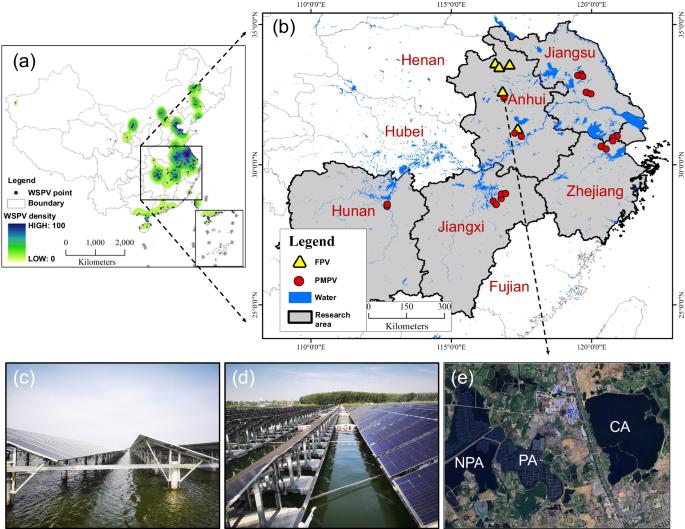水面光伏系统影响了水的物理和化学特性以及生物多样性
IF 8.1
1区 地球科学
Q1 ENVIRONMENTAL SCIENCES
引用次数: 0
摘要
近几十年来,水面光伏系统作为一种可再生能源在全球范围内迅速发展。水面光伏发电避免了对陆地生态系统的负面影响,但对水生物理和化学特性以及生物多样性的影响尚不清楚。为了解水面光伏系统对生态和环境的影响,我们于 2022 年冬夏两季对中国长江流域 26 个水面光伏系统的水体理化性质、浮游生物和鸟类群落进行了实地调查。我们发现,水面光伏系统降低了水温、溶解氧饱和度和水面覆盖面积,导致浮游生物种类和个体密度减少,改变了群落组成。水面光伏系统还导致鸟类多样性总体下降,并改变了鸟类群落组成。这些发现表明,水面光伏系统会对水环境和生态产生影响。由于水面光伏系统在未来将继续扩大,我们的研究结果强调了合理规划对于水面光伏系统的可持续发展以及水环境和生物多样性的保护至关重要。根据 2022 年冬季和夏季在中国长江流域的实地调查,在安装了水面光伏系统的地方,浮游生物物种丰富度和个体密度以及鸟类多样性都有所下降。本文章由计算机程序翻译,如有差异,请以英文原文为准。

Water-surface photovoltaic systems have affected water physical and chemical properties and biodiversity
The implementation of water-surface photovoltaic systems as a source of renewable power has expanded rapidly worldwide in recent decades. Water-surface photovoltaic avoids negative impacts on terrestrial ecosystems, while the impacts on aquatic physical and chemical properties and biodiversity are unclear. To understand the ecological and environmental impacts of water-surface photovoltaic systems, here we conducted a field survey on water physical and chemical properties, plankton and bird communities of 26 water-surface photovoltaic systems in the Yangtze River basin in China during the winter and summer of 2022. We found that water-surface photovoltaic systems decreased water temperature, dissolved oxygen saturation and uncovered area of the water surface, which caused a reduction in plankton species and individual density, altering the community composition. Water-surface photovoltaic systems also caused an overall decrease in bird diversity and changed bird community compositions. These findings suggested that water-surface photovoltaic systems have impacts on the water environment and ecology. Since water-surface photovoltaic systems will continue to expand in the future, our results emphasize that rational planning is critical for the sustainable development of water-surface photovoltaic systems and the protection of the aquatic environment and biodiversity. Plankton species richness and individual density, and bird diversity decreased where water-surface photovoltaic systems were installed, according to a field survey in the Yangtze River basin, China during the winter and summer of 2022.
求助全文
通过发布文献求助,成功后即可免费获取论文全文。
去求助
来源期刊

Communications Earth & Environment
Earth and Planetary Sciences-General Earth and Planetary Sciences
CiteScore
8.60
自引率
2.50%
发文量
269
审稿时长
26 weeks
期刊介绍:
Communications Earth & Environment is an open access journal from Nature Portfolio publishing high-quality research, reviews and commentary in all areas of the Earth, environmental and planetary sciences. Research papers published by the journal represent significant advances that bring new insight to a specialized area in Earth science, planetary science or environmental science.
Communications Earth & Environment has a 2-year impact factor of 7.9 (2022 Journal Citation Reports®). Articles published in the journal in 2022 were downloaded 1,412,858 times. Median time from submission to the first editorial decision is 8 days.
 求助内容:
求助内容: 应助结果提醒方式:
应助结果提醒方式:


